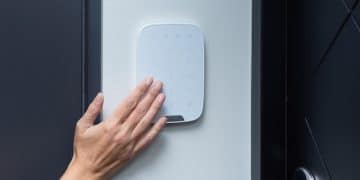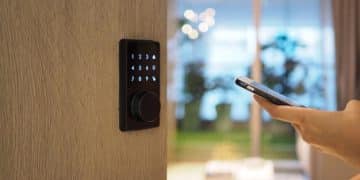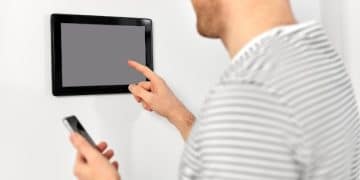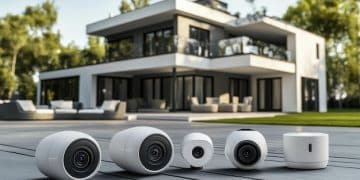Smart Locks: Upgrade Your Home Security Step-by-Step
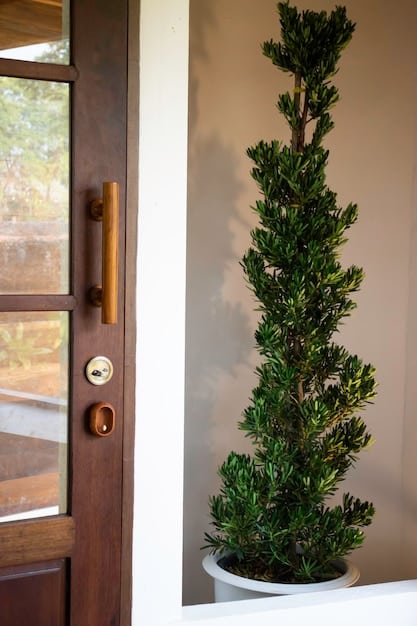
Upgrade Your Home Security: A Step-by-Step Guide to Smart Locks provides a comprehensive overview of how to enhance your home’s security using smart lock technology, covering installation, features, benefits, and maintenance tips to ensure a safer and more convenient living environment.
Enhance your home’s security with the latest technology. This guide will walk you through how to upgrade your home security: a step-by-step guide to smart locks, ensuring your peace of mind and convenience.
Understanding Smart Locks: An Introduction
Smart locks represent a significant advancement in home security, offering keyless entry and enhanced control over who accesses your property. They integrate seamlessly into the smart home ecosystem, allowing for remote management and monitoring.
These devices not only provide convenience but also add a layer of security that traditional locks cannot match.
What are Smart Locks?
Smart locks are electromechanical locks that allow you to open and close your doors without physical keys. They use wireless technology such as Bluetooth, Wi-Fi, or Z-Wave to communicate with your smartphone or other smart home devices.
- Keyless entry: Unlock your door using a smartphone app, a keypad, or even your fingerprint.
- Remote access: Grant access to family, friends, or service providers from anywhere.
- Activity monitoring: Track who enters and exits your home and receive real-time notifications.
Smart locks often come equipped with features such as tamper alerts, auto-locking, and integration with other smart home systems like security cameras and alarm systems. This makes them a valuable addition to any home security setup.

Benefits of Upgrading to Smart Locks
Investing in smart locks can provide numerous benefits beyond simply securing your home. They offer convenience, control, and enhanced security features that traditional locks cannot match.
Let’s explore some of the key advantages of upgrading.
- Enhanced Security: Smart locks offer features like tamper alerts, encryption, and activity logs, making it harder for intruders to breach your home.
- Convenience: Keyless entry means no more fumbling for keys. Use your smartphone, a keypad, or even your voice to unlock your door.
- Remote Access: Grant temporary access to guests or service providers from anywhere, without the need to hand out physical keys.
With smart locks, you can also integrate them into your home automation system, creating a seamless and connected smart home experience. This integration allows for features like automated locking at certain times or when you leave home.
Step-by-Step Installation Guide
Installing a smart lock is a straightforward process that most homeowners can complete themselves. This step-by-step guide will walk you through the process.
Follow these instructions to ensure a successful installation.
- Remove Existing Lock: Start by removing your current deadbolt lock using a screwdriver.
- Install the Smart Lock: Insert the new smart lock’s bolt and strike plate into the door and frame.
- Connect the Wiring: Connect the necessary wires according to the manufacturer’s instructions.
- Sync with App: Download the smart lock’s app and follow the instructions to sync the lock with your smartphone.
After installation, test the lock to ensure it functions correctly. Make sure the app is properly connected and that all features are working as expected. If you encounter any issues, consult the manufacturer’s support resources.
Key Features to Look For
When choosing a smart lock, it’s essential to consider the features that best suit your needs. Not all smart locks are created equal.
Here are some key features to look for:
Connectivity Options
Consider whether the lock uses Bluetooth, Wi-Fi, Z-Wave, or a combination of these. Wi-Fi allows for remote access without additional hubs, while Z-Wave and Bluetooth may require a smart home hub.
Security Protocols
Look for locks that offer advanced encryption and tamper detection. Two-factor authentication can also add an extra layer of security.
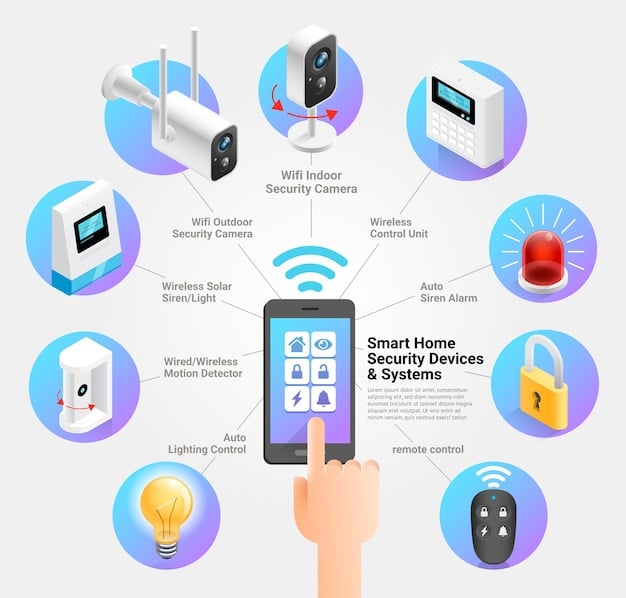
User Management
Ensure the lock allows you to easily add and remove users, set access schedules, and monitor activity logs. This is particularly useful for managing access for family members or service providers.
By considering these key features, you can choose a smart lock that provides the security, convenience, and control you need.
Integrating Smart Locks with Your Smart Home System
One of the biggest advantages of smart locks is their ability to integrate with other smart home devices and systems. This integration can create a more cohesive and automated home environment.
Here’s how you can integrate smart locks into your smart home system.
- Connect to Smart Home Hubs: Use hubs like Amazon Echo or Google Home to control your smart lock via voice commands.
- Integrate with Security Cameras: Pair your smart lock with security cameras to see who’s at the door before granting access.
- Set Automated Routines: Create routines that automatically lock the door when you leave home or at a specific time each night.
Integrating your smart lock with your smart home system can enhance both security and convenience, making your home smarter and more secure.
Maintenance and Troubleshooting Tips
Like any electronic device, smart locks require occasional maintenance to ensure they function correctly. Regular maintenance can extend the life of your smart lock.
Here are some maintenance and troubleshooting tips to keep your smart lock in top condition.
- Check Battery Life: Regularly check and replace batteries to avoid unexpected lockouts.
- Clean the Lock: Use a soft, dry cloth to clean the lock and keypad. Avoid using harsh chemicals or abrasive cleaners.
- Update Firmware: Keep the lock’s firmware updated to ensure it has the latest security patches and features.
If you encounter any issues with your smart lock, consult the manufacturer’s troubleshooting guide or contact their support team for assistance. Addressing problems promptly can prevent more significant issues down the road.
| Key Point | Brief Description |
|---|---|
| 🔑 Keyless Entry | Unlock your door using a smartphone, keypad, or fingerprint. |
| 📱 Remote Access | Grant temporary access to guests or service providers from anywhere. |
| 🛡️ Enhanced Security | Features like tamper alerts and activity logs protect your home. |
| 🔋 Battery Maintenance | Regularly check and replace batteries to avoid lockouts. |
Frequently Asked Questions
▼
Yes, most smart locks are designed for easy installation and can be installed by homeowners with basic tools. They typically come with detailed instructions and video tutorials to guide you through the process.
▼
Like any electronic device, smart locks are vulnerable to hacking, but manufacturers implement security measures like encryption and tamper alerts to minimize this risk. Keeping the firmware updated is crucial to protect against vulnerabilities.
▼
Most smart locks are battery-powered and will continue to function during a power outage. Some models also have a physical key option as a backup. Always ensure the batteries are regularly checked and replaced.
▼
Smart locks are designed to be compatible with most standard doors. However, it’s essential to check the lock’s specifications and ensure it fits your door’s thickness and dimensions. Some doors may require additional modifications.
▼
Smart locks allow you to grant temporary access codes to guests through the smartphone app. You can set specific dates and times for the access code to be active, ensuring that guests can only enter during the designated period.
Conclusion
Upgrading to smart locks is a worthwhile investment for enhancing your home security and enjoying the convenience of keyless entry. By following this guide, you can choose the right smart lock for your needs, install it correctly, and integrate it into your smart home system, providing yourself with peace of mind and added security.
